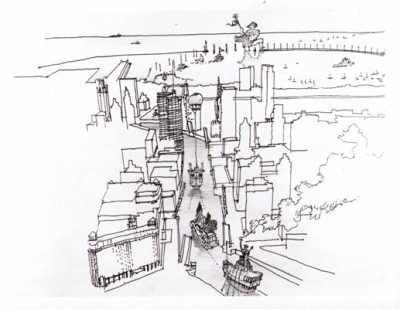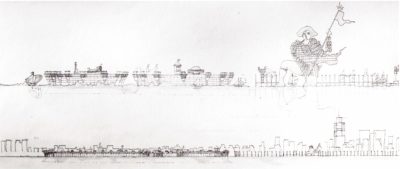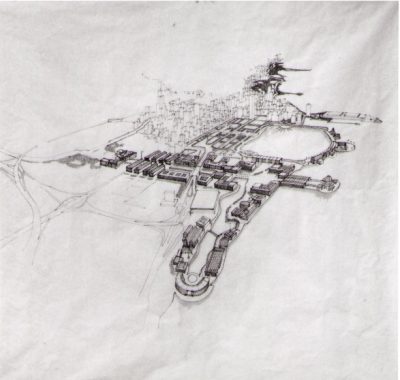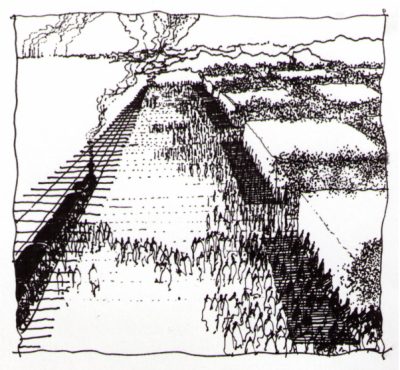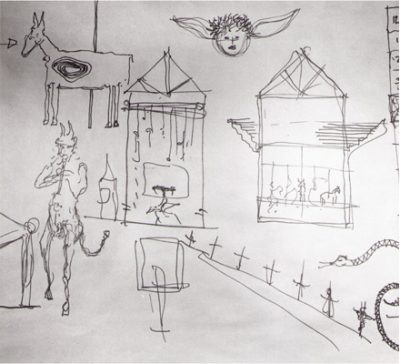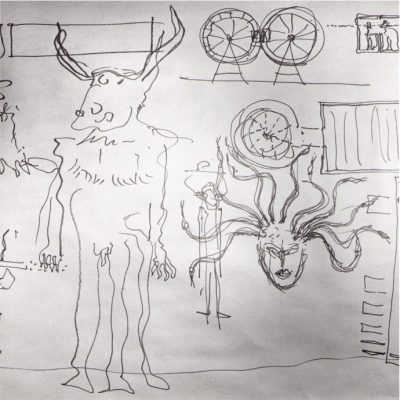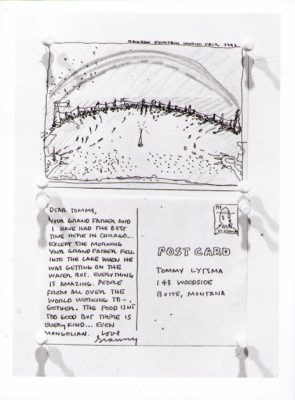Exhibitions
ABOUT THE EXHIBITION
Designing a World ’s Fair: The Age of Discovery is an exhibition of drawings, which are the products of three design conferences organized by the Chicago Central Area Committee, a civic organization comprised of Central Area businesses and institutions dedicated to making Chicago a better place to live, work, visit and conduct business. At Columbia University in New York (June 28-29), UCLA (Sept. 13-14) and Chicago on the University of Illinois campus (Oct. 31-Nov.1), nationally reputed architects joined together with students from area schools to consider this directive: “Today’s design problem is to locate, conceptualize, configure and layout a plan for the 1992 Chicago World’s Fair.” The purpose of the symposia and design workshops was to generate a set of philosophical and physical guidelines by which planning for the fair might have been directed over the next nine years. In addition to making the results of this series available to all interested parties, they were compiled and submitted formally to the Chicago World’s Fair-1992 Corporation.
“Today’s design problem is to locate, conceptualize, configure and layout a plan for the 1992 Chicago World’s Fair.”
The organizers provided drawing supplies, maps of the south lakefront site, attendance numbers and other data; architects donated their time, talents and experience. Each of four teams at the three locations claimed at least one Chicago-area architect. Each design conference lasted two days.
Gallery 400 presented the 1992 World’s Fair drawings beginning with the New York teams’ efforts, followed by those produced in Los Angeles, and finally those completed in Chicago. Relating all the designs was a focus on the south lakefront site. Architects considered a variety of issues: celebratory symbolism, references to past Fairs, how to connect various neighborhoods to the Fairgrounds, “residuals” (permanent architectural benefit to the city of Chicago), the development of the 18th Street canal, and thematic rather than national pavilions to highlight cooperative rather than competitive human interaction.
The 1992 Chicago World’s Fair was conceived to commemorate the 500th anniversary of Columbus’ discovery of the New World and the 100th anniversary of Chicago’s 1893 World’s Columbian Exposition. The theme of “The Age of Discovery” described a vision of all nations joining hands in celebrating the 500th anniversary of the discovery of the Americas and the great worldwide discoveries in all fields since then and to come.
ARTISTS
Stanley Tigerman, Frank Gehry, Chuck Quinlan, Cynthia Weese, William Turnbull, Daniel Solomon, Gerald Horn, Marc Goldstein, Charles Moore and John Ruble, Adrian Smith, Anthony Lumsden, Stephanos Polyzeides and Peter deBretteville, Robert Venturi, Darcy Bonner, Andrew Heard, Peter Eisenman, Helmut Jahn, Ronald Krueck, Jacquelin Robertson, James Nagle, Diane Legge Lohan, Max Bond, Werner Seligmann, Frederick Phillips, Richard Meier, Laurence Booth, Thomas Beeby, Dirk Lohan, Robert Stern, Denis Scott-Brown, Raoul De Armas, James Stewart Polshek, Henry N. Cobb, John Hejduk, Adele Santos, Ralph Johnson, and Bruce Graham
SUPPORT
Designing a World’s Fair: The Age of Discovery is supported by the University of Illinois at Chicago School of Art and Design’s College of Architecture, Art and Urban Planning.


